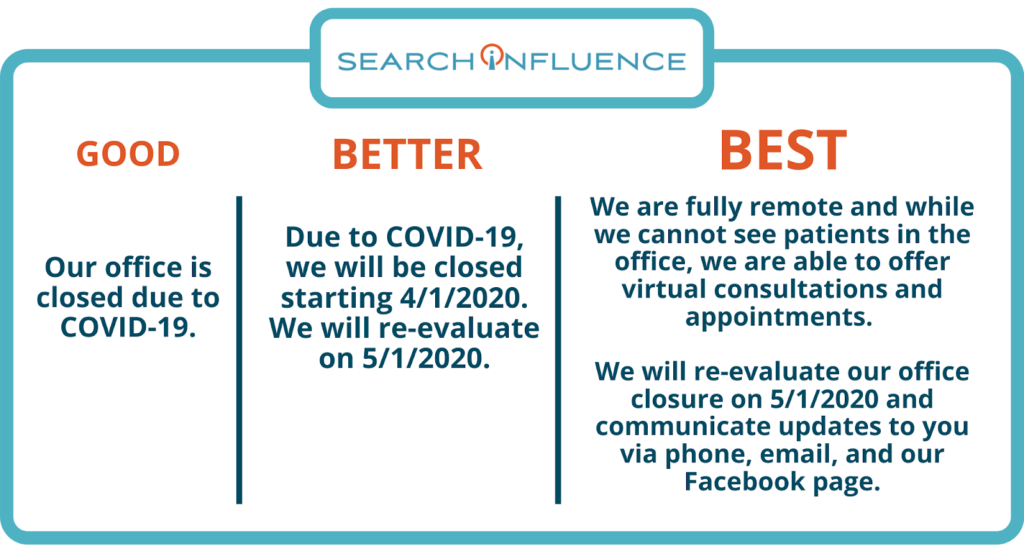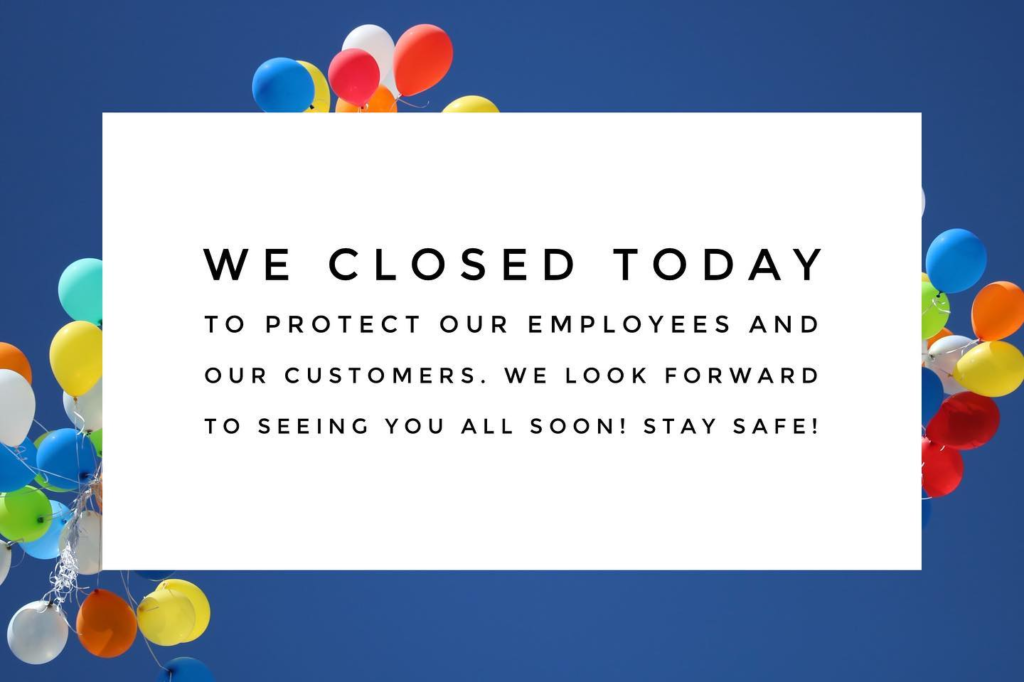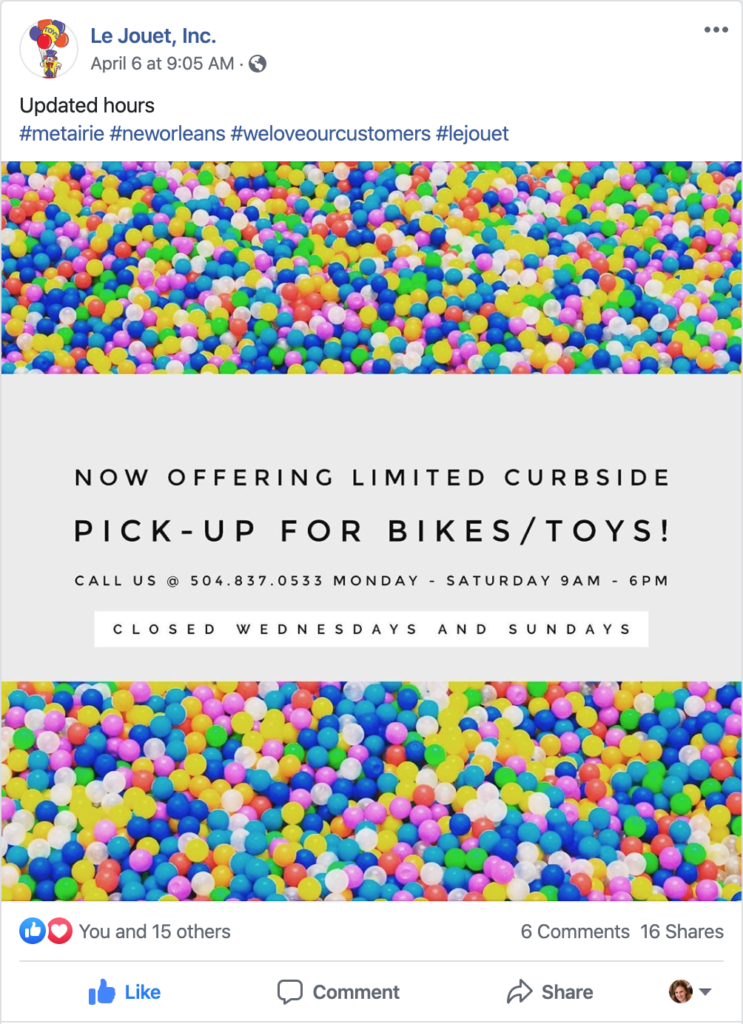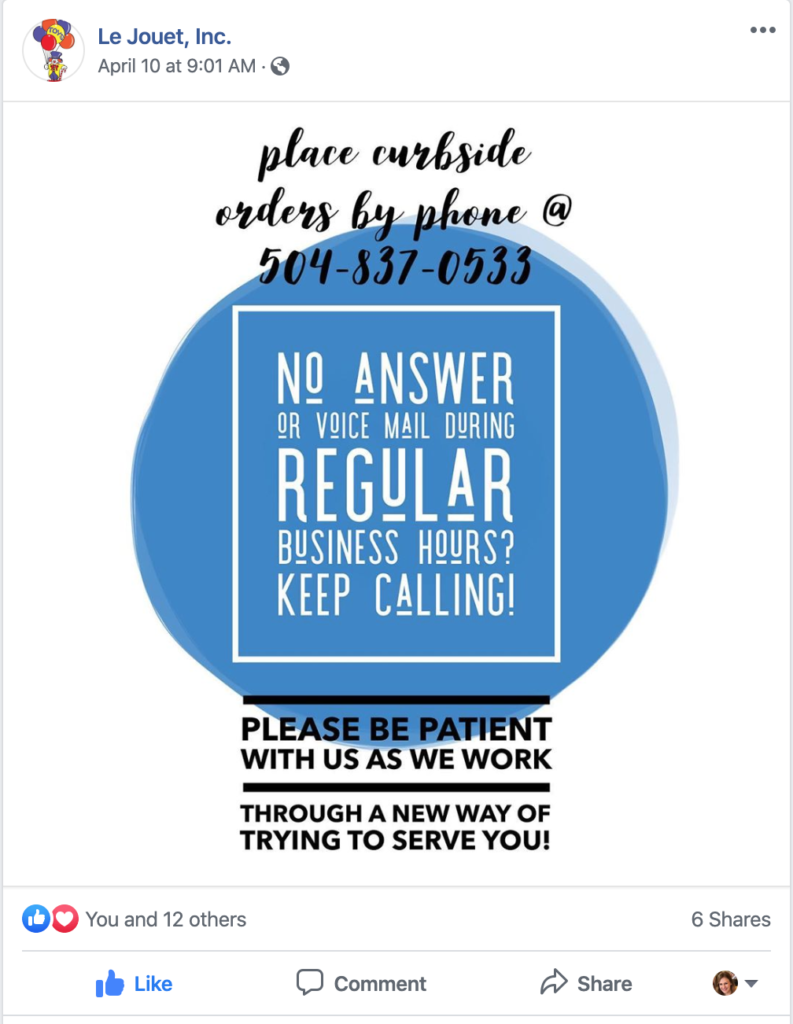Business Continuity Messaging During COVID-19: What You Need to Do Right Now
May 13th, 2020 by
Now more than ever, the internet is the first and primary source of information about local businesses. The messaging (or lack thereof) that companies disseminate may affect the quality and quantity of their customers when the economy begins to open back up.
We’ve seen far too many businesses fail to communicate their situation, regardless of whether they are open at this time. You already have the tools to communicate to your customers:
- Your website
- Social media
- Your CRM or customer email list
- Google My Business
Ensure that you’re poised for recovery by addressing your messaging strategy now. Create a plan to keep or build your audience’s trust.
To remain top-of-mind, you must cultivate customer intent. It will be more competitive when the economy opens back up, so you want potential customers to be further down the sales funnel at that point. Many people want and intend to spend their money with local businesses or on causes impacting their communities.
Messaging Guidelines
Prior to the pandemic, Millennials (in 2020, this includes people who are 24-39 years old) were projected to represent $1.4 trillion in buying power this year. They now make up the largest segment of the workforce, are the most common users of social media and most likely to buy online.
Millennials spend their money in alignment with their values and often spend more on a product if the brand contributes to charitable causes. In March 2020, Millennials indicated they expect brands to step up their communication during this crisis:
- One-third of respondents said that brands should communicate more than normal.
- Half of the respondents thought that brands should continue their marketing efforts during this time.
- One in four of those surveyed also said that they believed brands have the power to be “as impactful as the government” during this crisis.
Ensure Clarity in Your Messaging
Marketing messaging now needs to focus on making positive brand impressions. Whenever possible, demonstrate social responsibility and clarify to your current and prospective customers how your business is operating during this period.
If your business is operating:
- Which steps do customers need to take to get in touch?
- What is your plan for the short and long term?
- How are you ensuring customer and employee safety?
- Is your business supporting the community with donations, fundraisers, etc.?
- If so, how are you doing this?
- How can your audience help?
If you are unable to do business as usual:
- How has this situation impacted the business and your employees?
- How can your audience help?
- Is your business supporting the community (i.e., donations, fundraisers, etc.)?
- If so, how are you doing this?
- How can your audience help?
Don’t Add to the Noise: Make Relevant and Meaningful Updates
If you’re in a community with stay-at-home orders or one that has been hit particularly hard, it’s important to keep your audience up-to-date. An update of “No change in business at this time. We will keep you updated,” is better than radio silence.
Savvy consumers understand the dynamic nature of doing business today and are more tolerant than normal about changes. Don’t withhold an update because you fear things may change. Even if you’re a small business that has relied on in-store sales and light social media posting to drive business, there are opportunities to be agile.
For example, an iconic New Orleans toy store initially closed to comply with stay-at-home orders. As they realized they could keep people safe and still move inventory by offering personal shopping and curbside pickup services, they made adjustments and kept their customers informed.
Do Good. Get Good: Earned Media for Those Who Communicate
A strong communication plan helps earn customer loyalty and saves a deferred investment due to lost customers. In the short term, you may even get some added exposure by earning media mentions and placements because of the good you are doing.
One of our clients, Audubon Nature Institute, allowed an African penguin to tour the empty Aquarium of the Americas and used the hashtag #ClosedButStillCaring. The public loved it and demanded more, so Audubon produced a video of the penguins roaming the Aquarium. Local media outlets always look for feel-good stories and they picked up this one!
Messaging Tactics
Ensure this information is accessible to anyone who needs it.
Audit All Messaging
Audit and create a list of all customer / prospect touchpoints. Look at everything, from the obvious (social media and website content) to the less obvious (your voicemail recording when someone calls).
Examples of communications to audit:
- Your voicemail recording
- Any automated responses someone might receive if they fill out an inquiry on your website.
- Online appointment confirmation emails
- Online order confirmation emails
- If someone on your Houzz.com profile (or any other 3rd party website), do they receive a different automatic email? If you have the ability to update the content, make sure you include this in your audit.
Google My Business COVID-19 Considerations
Website traffic data indicates people are more likely to Google you first, even loyal customers. With Google presenting more and more information in the search results, people will often read the information in Google’s knowledge panel without making it to your website.
Update your Google My Business by using these features:
- If you’re closed, mark your business as Temporarily Closed
- Create Posts on GMB
- Take advantage of the new COVID-19 update post
- If you are offering telehealth services, take advantage of the “Get Online Care” link that now appears directly in search results
Write a COVID-19 Business Statement
Now that many states and communities are on the cusp of re-opening some businesses, it’s critical to communicate clearly and effectively with customers and employees about what is and isn’t expected at your establishment.
Make a specific page on your website dedicated to your COVID-19 statement and updates. We recommend that you also add a sticky banner or pop-up that links to this page site-wide. This should be obvious because it’s the first info people are looking for when they visit your site right now.
There is a free WordPress plugin for this feature, and tools like Unbounce can also accomplish this. Here are some examples from our clients:
In our next post, we’ll dive deeper into what the experts say about marketing during the COVID-19 outbreak, including how you can make messaging effective if you do continue advertising. Stay tuned for more COVID-19 marketing content from the team at Search Influence!





